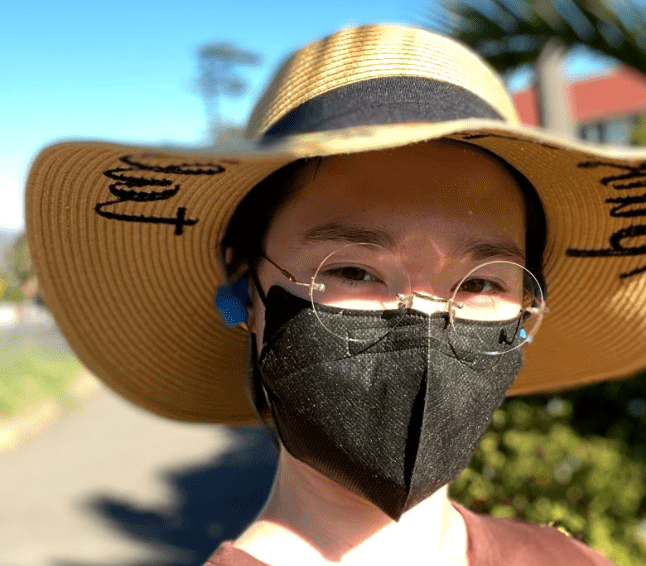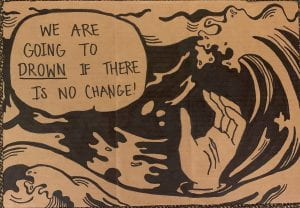
Art Within Activism
In this week’s blog, Design major and Classical Studies minor Maj Jenkins (’22), writes about their experience in the University of San Francisco’s Design Activism Class. Through the course, students are paired with Community Action Partners to create designs that can represent the partner’s values and mission. Read on for Maj’s view on how design can be a tool for change.
What is Design Activism?
Design Activism is the idea of using design as your voice to create social change, with the designer taking the role of a facilitator rather than an expert to work with communities to find the solutions which best benefit them.
At USF, Design students have the opportunity to take a course in Design Activism Community Engaged Learning where they get a chance to apply these concepts in their practice. As a class, we address significant socio-political topics with our voices and our art in unison. Outside of class, we are assigned in groups to work with community partners as our clients, with the class functioning like a mock design firm and giving students needed experience.
Community Partners? What are those?
Community Partners are the organizations we are partnering with as design students at USF. These organizations all deal with pursuing social change. They include South of Market Community Action Network (SOMCAN), Girls on the Run, New Community Leadership Foundation (NCLF), Asian Uplift, and New Story Center.
Why is Design Activism important?
Design Activism is important to me because I see how the capitalist world around us has commodified design and uses it to manipulate people in a consumer setting. We define “good design” as the shiniest latest hand-held technology, but not the protest signs and methods of demonstrators advocating change. We consider a good user experience to be the one of most convenience for white-collar workers, for whom it is so easy as to open an app on their smartphone to order dinner, but not the blue-collar workers who farm, wash, package, ship, prepare, and deliver their food to their doorstep. Why should good design only be defined as coming out of multimillion dollar Silicon Valley, and only benefitting those who can afford it?
Design Activism’s existence and implementation as a course reminds me why I chose USF over other universities when I was debating my college acceptances and comparing design programs. Design should be used as a tool for change, the spirit of communities, and not limited to the hands of the elite and exclusive. Design should break down borders, not build more of them.
Which were the most significant Design Sprints to you and why?
One thing I have learned since taking this course is that design does not have to be professional — It’s a bit contradictory since we’re learning how to be professional designers, but design isn’t confined to refined graphics created in Adobe Suite. It can be done by anyone. At first, this was intimidating to me, because like any other student, I want to ensure my job security when I graduate — but not taking the role of an exclusive expert does not mean I’ll be out of a job. It means that I will be able to communicate with those on my team better, deliver more comprehensive and useful results, and more fully engage with the work I am doing.
Throughout the semester in-class, we’ve done “design sprints” – quick design exercises. I recommend them to anyone who wants to try if you have free time, you don’t even have to be a creative sort.
My favorite design sprints that we have done are creating postcards to send to each other and to two representatives of our choice. The class had great variation on topic choice as the prompt was simply “what do you feel is important right now” – many chose political sentiments as well as self-care ones. We were able to campaign for something we cared about, have a political voice, and stay connected with each other.
Another design sprint that we did was to create signs with cardboard to put in our windows, choosing political messages such as encouraging voters. Another aspect of some of the design sprints is making them with our hands and physical materials so that we can get away from the screen for a while (especially as screen time has increased in online learning).
What does it mean to partner with a community partner and what are some things you have learned in your class?
It has been a very valuable experience to me to work in a group with a community partner as it’s demonstrated to me how the role of the designer is not always focused on creative, but facilitatory skills. I have learned that as a designer you have to be open to change and communicate heavily with your team and your client.
What can I do as a reader?
- Consider how design has shaped your community, and study how design has been used to both manipulate and empower. What are some examples you can think of where you felt manipulated as a consumer by a design, or used a well-designed product or service that benefitted from underpaid labor? What are some examples you can think of when you felt empowered from seeing design? What design has made you feel closer to your community and the issues you care about?
- Design activist artwork yourself! Think about ways you can perform small acts of design that will be easy and fun for you. Examples, some of which we have used in class, include: making digital and physical signs, drawing what you think a liberated world looks like, writing post-it notes to the people you care about, making masks for the pandemic, using chalk to create a message… the world is your oyster.
- Learn more about the Design program at USF, and consider declaring your major in it, or adding the minor (we have a lot of fun!): https://www.usfca.edu/arts-sciences/undergraduate-programs/art-architecture/design
















